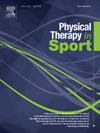Isometric and isokinetic hip strength in males with chronic ankle instability and its relationship with dynamic balance and self-reported instability
IF 2.2
3区 医学
Q1 REHABILITATION
引用次数: 0
Abstract
Objectives
To investigate isometric and isokinetic hip strength as well as dynamic balance in males with chronic ankle instability (CAI) and explore potential associations between hip strength, dynamic balance, and self-reported instability.
Design
Cross-sectional study.
Setting
University laboratory.
Participants
Fifty male participants (25 with CAI and 25 healthy controls).
Main outcome measures
Hip isometric and isokinetic torque normalized to body weight, Lower Quarter Y-balance Test (YBT-LQ), the Polish version of The Cumberland Ankle Instability Tool (CAIT-PL).
Results
Significant differences were observed only in the hip isometric abductors/adductors strength ratio (p = 0.034, ES = 0.65), which was lower in the CAI group. CAI participants showed reduced dynamic balance in posterolateral reach (p = 0.006, ES = 0.92) and composite score of YBT-LQ (p = 0.012, ES = 0.91). There was a moderate positive correlation between dynamic balance and hip abductors strength during posteromedial (r = 0.40, p = 0.049) and posterolateral (r = 0.40, p = 0.048) YBT-LQ reaches, and isometric hip abductors strength moderately positively correlated with self-reported instability (r = 0.46, p = 0.021) in the CAI group.
Conclusion
Males with CAI exhibit deficits in frontal plane hip isometric strength, specifically in the hip abductor/adductor ratio, while no deficits were observed in isokinetic strength. The relationships between hip abductors strength, dynamic balance, and self-reported ankle instability may suggest the importance of hip abductors isometric strength for functional outcomes in CAI-patients.
男性慢性踝关节不稳定的等长和等速髋关节力量及其与动态平衡和自述不稳定的关系
目的探讨慢性踝关节不稳定(CAI)男性患者髋部力量、动态平衡和髋部力量、动态平衡与自我报告不稳定之间的潜在联系。DesignCross-sectional研究。SettingUniversity实验室。参与者:50名男性参与者(25名CAI患者和25名健康对照)。主要结果测量:等距和等速扭矩归一化到体重,下季度y平衡测试(YBT-LQ),波兰版的Cumberland踝关节不稳定工具(CAIT-PL)。结果仅髋关节内收肌/外展肌力量比有显著性差异(p = 0.034, ES = 0.65), CAI组较低。CAI参与者表现出后外侧运动平衡下降(p = 0.006, ES = 0.92)和YBT-LQ综合评分(p = 0.012, ES = 0.91)。在YBT-LQ到达后内侧(r = 0.40, p = 0.049)和后外侧(r = 0.40, p = 0.048)时,动态平衡与髋外展肌力量之间存在中度正相关,CAI组髋外展肌力量与自我报告的不稳定性之间存在中度正相关(r = 0.46, p = 0.021)。结论男性CAI患者表现出髋额平面等速力量的缺陷,特别是髋关节外展/内收比的缺陷,而等速力量未见缺陷。髋外展肌力量、动态平衡和自我报告的踝关节不稳定之间的关系可能提示髋外展肌等长力量对cai患者功能结局的重要性。
本文章由计算机程序翻译,如有差异,请以英文原文为准。
求助全文
约1分钟内获得全文
求助全文
来源期刊

Physical Therapy in Sport
医学-康复医学
CiteScore
4.50
自引率
8.30%
发文量
125
审稿时长
39 days
期刊介绍:
Physical Therapy in Sport is an international peer-reviewed journal that provides a forum for the publication of research and clinical practice material relevant to the healthcare professions involved in sports and exercise medicine, and rehabilitation. The journal publishes material that is indispensable for day-to-day practice and continuing professional development. Physical Therapy in Sport covers topics dealing with the diagnosis, treatment, and prevention of injuries, as well as more general areas of sports and exercise medicine and related sports science.
The journal publishes original research, case studies, reviews, masterclasses, papers on clinical approaches, and book reviews, as well as occasional reports from conferences. Papers are double-blind peer-reviewed by our international advisory board and other international experts, and submissions from a broad range of disciplines are actively encouraged.
 求助内容:
求助内容: 应助结果提醒方式:
应助结果提醒方式:


